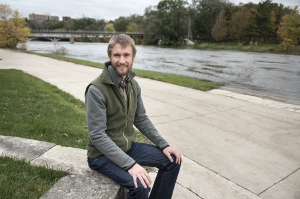What’s in the Water?
April 11, 2016
by Shianne Fisher
The longstanding conversation about nutrients in Iowa waterways has only become more heated over the past few years. The connection to agriculture is implicit, but what about the other contaminants entering our rivers and streams? Via our sinks, showers, toilets and roads, numerous substances make their way through our water treatment systems, where they are (theoretically) either broken down or removed. However, a number of researchers at IIHR—Hydroscience and Engineering say that may not always be the case.

Greg LeFevre is particularly interested in what becomes of certain contaminants as they move through the final stages of the water cycle.
Greg LeFevre, who joined IIHR in January as an assistant research scientist, is particularly interested in what becomes of certain contaminants as they move through the final stages of the water cycle. LeFevre studies biotransformation—or the chemical alteration—of contaminants in aquatic environments. Just as the body metabolizes a toxin, plants and microbes “digest” waterborne pollutants, turning them into—what?
“We’ve come to the realization that what the contaminant turns into is not necessarily always a harmless thing,” says LeFevre, who is also an assistant professor of civil and environmental engineering. “Sometimes the bioactivity of those transformation products can be just as strong or sometimes more toxic than the original compound. It’s not always necessarily super easy to predict.”
Of course, drinking water supplies in the United States are among the safest in the world and must follow the high standards laid down by the Environmental Protection Agency’s Safe Drinking Water Act. It’s highly unlikely that the water in your home would ever be compromised. However, in light of the Flint water crisis, it’s become clear that the monitoring of our drinking water is essential to the future of municipal water systems—and to our health and safety.
For years, researchers at IIHR have conducted case studies of groundwater contaminants, such as arsenic. With the 2014 addition of the Iowa Geological Survey, researchers have begun projects to improve water quality through restored and constructed wetlands, and to help cities make smart decisions on treatment strategies in an increasingly flood- and nutrient-prone region. Most recently, the Iowa Flood Center released its new Iowa Water Quality Information System (IWQIS), which allows users to monitor nitrate and other water parameters across the entire state.
LeFevre’s passion for engineered and natural systems (ENS), which use natural functions of plants, soil and organisms to help clean waterways, could help the research community and key decision-makers implement more effective and efficient designs. “Sometimes people put them in just because they’re pretty,” says LeFevre, “but we need to make sure they actually work.”
LeFevre received a postdoc in environmental engineering and science at Stanford, where he worked with the National Science Foundation Research Center for Re-Inventing the Nation’s Urban Water Infrastructure (ReNUWIt). His research focused on plant transformation of emerging contaminants in recycled water, with the idea that highly treated wastewater would be used for irrigation. He also worked on improving large-scale storm water collection systems in California. “Groundwater is being overdrawn, and that’s a big thing,” he says, “but there’s not necessarily as much consideration for the pollutant removal and water quality prior to recharge.”
All in all, LeFevre says that biological processes are extremely underexploited in water treatment. “Bacteria work real cheap,” he says. “If you have the chemical removal as well as biological biodegradation, they can kind of work together so that pollutants are removed and then degraded effectively.”
LeFevre says he is looking forward to cross-collaboration on water-quality research at the university. “I think that the future is really bright for a one-water state of mind in terms of water quantity and water quality and how those things are not mutually exclusive considerations, but are really obligatory to moving forward with success.”
Read more about emerging contaminants research by new IIHR undergraduate research assistant Kathryn Klarich.



